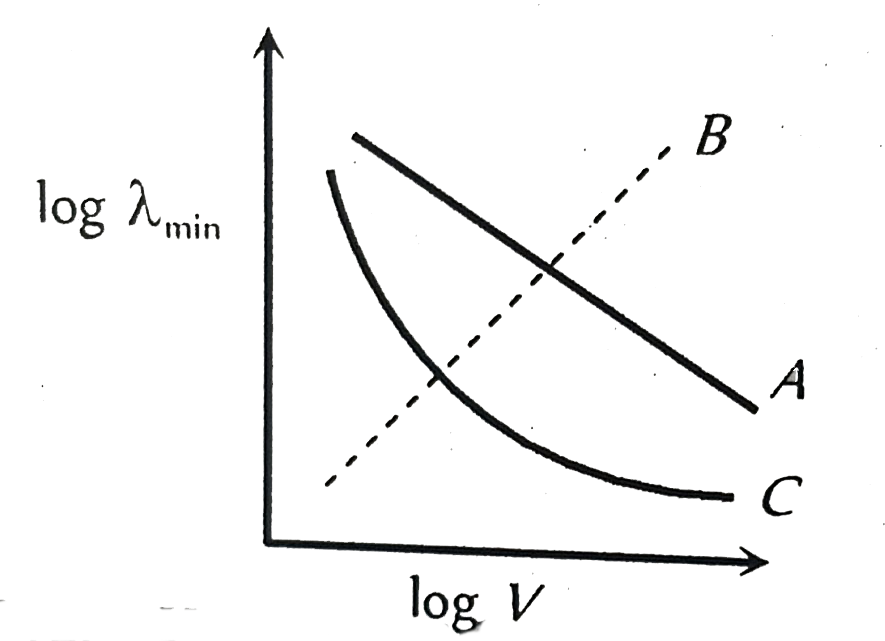A mercury lamp is a convenient source for studying frequency dependence of photoelectric emission, since it gives a number of spectral lines ranging from the UV to the red and end of the visible spectrum. In our experiment with rubidium photocell, the following lines from a mercury source were used:
The stopping voltages, respectively, were measured to be:
Determine the value of Planck's constant h, the threshold frequency and work function for the material.
Frequencies corresponding to different wavelengths of spectral lines of mercury are

and
From the given data, we plot the graph, which comes out to be as shown in figure. first four points lie on a straight line but the fifth point does not lie on straight line. it means that .
(a) A careful measurement shows that slope of straight line graph is
(b) From graph intercept along v-axis is found to be .
Threshold frequency
Work function
.
Related Playlists
- BOOK - U-LIKE SERIESCHAPTER - DUAL NATURE OF RADIATION AND MATTEREXERCISE - CASE BASED/SOURCE-BASED INTEGRATED QUESTIONS10videos
DUAL NATURE OF RADIATION AND MATTER
- BOOK - U-LIKE SERIESCHAPTER - DUAL NATURE OF RADIATION AND MATTEREXERCISE - MULTIPLE CHOICE QUESTIONS30videos
DUAL NATURE OF RADIATION AND MATTER
- BOOK - U-LIKE SERIESCHAPTER - DUAL NATURE OF RADIATION AND MATTEREXERCISE - SELF ASSESSMENT TEST SECTION-C (VERY SHORT ANSWER QUESTIONS)3videos
DUAL NATURE OF RADIATION AND MATTER
- BOOK - U-LIKE SERIESCHAPTER - CURRENT ELECTRICITY EXERCISE - SELF ASSESSMENT TEST (SECTION C )3videos
CURRENT ELECTRICITY
- BOOK - U-LIKE SERIESCHAPTER - ELECTRIC CHARGES AND FIELDS EXERCISE - SELF ASSESSMENT TEST (SECTION-B) (VERY SHORT ANSWER QUESTIONS)4videos
ELECTRIC CHARGES AND FIELDS
Similar Questions
A mercury lamp is a convenient source for studying frequency dependence of photoelectric emission, since it gives a number of spectral lines ranging from the UV to the end of the red visible spectrum. In our experiment with rubidium photocell, the following lines from a mercury source were used: λ1=3650A∘,λ2=4047A∘,λ3=4358A∘,λ4=5461A∘,λ5=6907A∘ The stopping voltages, respectively were measured to be:
V01=1.28V,V02=0.95V,V03=0.74V,V04=0.16V,V05=0V.
(a) Determine the value of Planck's constant h.
(b) Estimate the threshold frequency and work function for the material.View SolutionA mercury lamp is a convenient souce for studying frequency dependence of photoelectric emission, since it gives a number of spectral lines ranging from the UV to the end of the red vissible spectrum. In our experiment with rubidium photocell, the following lines from a mercury source were used: λ1=3650A∘,λ2=4047A∘,λ3=4358A∘,λ4=5461A∘,λ5=6907A∘ The stopping voltages, respectively were measured to be:
V01=1.28V,V02=0.95V,V03=0.74V,V04=0.16V,V05=0V.
(a) Determine the value of Planck's constant h.
(b) Estimate the threshold frequency and work function for the material.View SolutionThe dependence of the short wavelength limit λmin on the accelerating potential V is represented by the curve of figure
 View Solution
View SolutionX-rays of λ=1Å have frequency
View SolutionX-rays of λ=1Å have frequency
View SolutionThe ration of resolving powers of an optical microscope for two wavelangths
λ1=4000 Åandλ2=6000ÅisView SolutionThe ration of resolving powers of an optical microscope for two wavelangths
λ1=4000 Åandλ2=6000ÅisView SolutionFor photoelectric effect with incident photon wavelength λ, the stopping potential is V0 Select the correct graph.
View Solutionif λv',λx and λm represent the wavelengths of visible light X-rays and microwaves respectively then:
View Solutionif λv',λx and λm represent the wavelengths of visible light X-rays and microwaves respectively then:
View Solution

